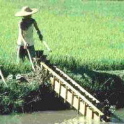The shrinking water table beneath China's northern plain is more than just a matter of concern to Beijing's National Development and Reform Commission. It makes strategic planners in Washington nervous too because it increases the likelihood that the Chinese will have to import significantly more grain. Given China's population of 1.3 billion and the rapidly growing urban middle classes with their rising taste for more western-style meat-oriented diets instead of traditional rice, this threatens to destabilize world grain markets, push up prices and lead to shortages, the Washington-based, internationally funded Worldwatch Institute has speculated. Water supply is becoming similarly stressed for China's burgeoning neighbor and the world's second most populous country. India, with 1.1 billion people occupying an area one-third the size of the United States, suffers from poor water delivery infrastructure as well as severe ground water contamination. In the capital New Delhi, at least 40 percent of the daily water supply pumped through the city is lost through leaking pipes.
China Faces Growing Water Shortage

